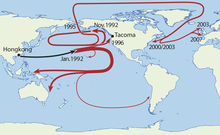Friendly floatees
Friendly floatees (engl., Dt. About Friendly Treibteilchen ) are a batch of rubber duckies and other plastic animals that became famous after they were in a storm overboard and drove in the sea. The toys were washed up on various coasts over a long period of time due to the ocean circulation and provided researchers with information about ocean currents . Lost bulk cargo is only part of a large amount of plastic waste in the oceans .
origin
The cargo ship Ever Laurel sailing under the Greek flag was caught in a severe storm on January 10, 1992 en route from Hong Kong to Tacoma ( Washington, USA ). In the North Pacific on the date line , it lost three containers. About 28,800 plastic animals were washed into the sea: yellow ducks, green frogs, blue turtles and red beavers.
Significance for oceanography

After eight months, the first toys washed up in Alaska . This caught the attention of ocean explorer Curtis Ebbesmeyer . After his research, many plastic animals reached Australia and Indonesia, as well as some Chile . Many ducks followed the Pacific Annular Current, which takes two to three years to complete one revolution. In 1995 it was finally discovered that toy animals were drifting from the Bering Sea through the Bering Strait into the pack ice of the Arctic Ocean .
Eventually, researchers at the Center of Oceanography in Southampton , including ocean currents researcher Simon Boxall, began studying the plastic animals. These passed the east coast of Greenland . In 2000 and 2003 there were finds in the US states Maine and Massachusetts . A bleached frog was found in the Hebrides in 2003. In August 2007, the Englishwoman Penny Harris reported the discovery of one of the ducks on a beach in Devon , around 27,000 km from the place of origin. From July to December 2003, the US manufacturing company First Years Inc. , whose name is written on the animals, offered a reward of 100 US dollars.
Climate researchers like Stefan Rahmstorf from the Potsdam Institute for Climate Research are also interested in the hiking trails of the Floatees. As a result of the Greenland ice melt in the course of climate change , fresh water is penetrating the Labrador Sea , the Arctic Ocean and the Greenland Sea , whereby the (lighter) fresh water does not sink as easily and thus slows the ocean currents.
However, floating debris on the surface is influenced by the wind, while scientific floating buoys can eliminate the influence of the wind by attacking surfaces deep in the water.
Reception in art
The Dutch artist Marga Houtman inspired the fate of the Floatees to create the more than two-meter tall Mother Duck sculpture , which is supposed to wait in England for the arrival of its little fellows.
The Austrian writer Heinrich Steinfest in his novel “The Scope of Hell” deals several times with the plastic ducks swimming around in the oceans as a result of this accident.
In addition, children's books have been published that take up the events, as well as the play for children Quietsch, the duck by Anne-Kathrin Klatt, premiered at the Landestheater Tübingen on December 1, 2007.
literature
- Curtis C. Ebbesmeyer, W. James Ingraham Jr .: Pacific Toy Spill Fuels Ocean Current Pathways Research. In: American Geophysical Union (Ed.): EOS , Volume 75, No. 37, September 13, 1994, doi : 10.1029 / 94EO01056 , pp. 425-430 (PDF; 1.3 MB) ( Memento from 21. October 2014 in the Internet Archive ).
- Donovan Hohn: Moby-Duck: The True Story of 28,800 Bath Toys Lost at Sea and of the Beachcombers, Oceanographers, Environmentalists, and Fools, Including the Author, Who Went in Search of Them . Viking, New York 2011, ISBN 978-0-670-02219-9 (English).
Web links
- MDR Echt !: Research with rubber ducks ( Memento from May 24, 2010 in the Internet Archive ) (from December 11, 2007, German)
- Spiegel Online: Thousands of rubber ducks set course for England (from July 1, 2007, German)
- Curtis C. Ebbesmeyer: Beachcombing Science from Bath Toys. (English)
- Timeline of Rubber Duck Voyage . Chronology on Rubaduck.com (English)
- CBS News: Rubber Duckies Map The World (dated Jul 31, 2003)
- Timesonline: Plastic duck armada is heading for Britain after 15-year global voyage (from June 28, 2007)
- Keith C. Heidorn: Of Shoes And Ships And Rubber Ducks And A Message In A Bottle (from March 17, 1999)
- Jane Standley: Ducks odyssey nears end (BBC News, Jul 12, 2003)
- David Adam: Duck ahoy (The Age, August 7, 2003)
Individual evidence
- ^ The great escape: the bath toys that swam the Pacific. theguardian.com, accessed July 25, 2014 .
- ^ Times Online: First of the plastic duck invasion fleet makes landfall on the Devon coast
- ^ Spiegel Online: After 15 years at sea. Thousands of rubber ducks set course for England , July 1, 2007
- ↑ Ducks embark on a scientific journey ( Memento from October 1, 2003 in the Internet Archive ) The First Years Inc. in the web.archive
- ↑ Moedereend in Cornwall . Retrieved April 23, 2019.
- ↑ Eric Carle: 10 Little Rubberducks. (Reviews)
- ↑ The Drifting Seed newsletter (PDF, p. 11, review of Ducky by Eve Bunting and David Wisniewski, English; 1.3 MB)
- ↑ Quietsch, die Ente, play for children, world premiere at LTT

